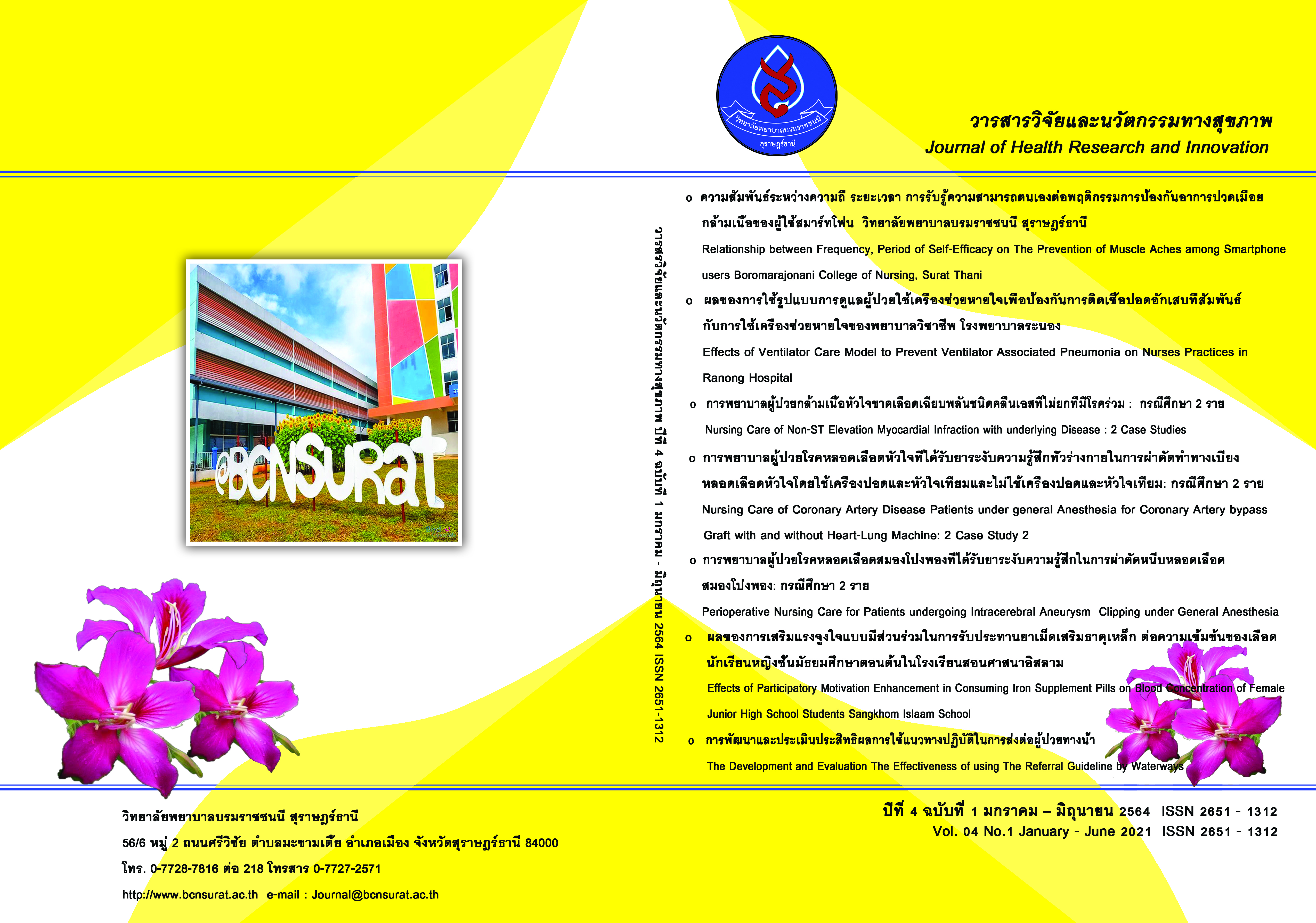ผลของการเสริมแรงจูงใจแบบมีส่วนร่วมในการรับประทานยาเม็ดเสริมธาตุเหล็ก ต่อความเข้มข้นของเลือดนักเรียนหญิงชั้นมัธยมศึกษาตอนต้นในโรงเรียนสอนศาสนาอิสลาม
คำสำคัญ:
การเสริมแรงจูงใจแบบมีส่วนร่วม, ยาเม็ดเสริมธาตุเหล็ก, ความเข้มข้นของเลือดนักเรียนหญิงบทคัดย่อ
การวิจัยนี้เป็นวิจัยกึ่งทดลองแบบกลุ่มเดียววัดแบบอนุกรมเวลานี้ มีวัตถุประสงค์เพื่อศึกษาผลของการเสริมแรงจูงใจแบบมีส่วนร่วมในการรับประทานยาเม็ดเสริมธาตุเหล็ก ต่อความเข้มข้นของเลือดนักเรียนหญิงชั้นมัธยมศึกษาตอนต้น โรงเรียนสังคมอิสลาม จำนวน 47 คน คำนวณกลุ่มตัวอย่างโดยใช้โปรแกรม G* Power โดยใช้วิธีสุ่มอย่างง่าย เครื่องมือที่ใช้ในการวิจัยคือการเสริมแรงจูงใจแบบมีส่วนร่วม และแบบบันทึกความเข้มข้นของเลือด วิเคราะห์ข้อมูลโดยใช้สถิติเชิงพรรณนา และการวิเคราะห์ความแปรปรวนเมื่อมีการวัดซ้ำทดสอบรายคู่ด้วยวิธี Bonferroni ผลการวิจัยพบว่า
ระดับความเข้มข้นของเลือดทั้ง 3 ครั้ง แตกต่างอย่างมีนัยสำคัญทางสถิติที่ระดับ .001 และเมื่อเปรียบเทียบความแตกต่างรายคู่พบว่า ระดับความเข้มข้นของเลือด หลังการทดลอง 2 เดือน สูงกว่า หลังการทดลอง 1 เดือน และก่อนการทดลองอย่างมีนัยสำคัญทางสถิติที่ระดับ .001
ดังนั้นควรมีการคัดกรองภาวะโลหิตจางในนักเรียนทุกระดับชั้น และควรขยายการคัดกรองภาวะโลหิตจางไปในโรงเรียนอื่นๆในพื้นที่รับผิดชอบ ร่วมเสนอกำหนดเป็นนโยบายของโรงเรียนให้นักเรียนที่มีภาวะโลหิตจางรับประทานยาเสริมธาตุเหล็ก 1 เม็ดต่อสัปดาห์เพื่อเป็นการป้องกันภาวะโลหิตจางที่อาจเกิดขึ้นได้
เอกสารอ้างอิง
Cohen, J. (1977). Statistical Power Analysis for the Behavioral Sciences. (2nd). Hillsdale, NewYork: Lawrence Erlbaum Associates, Publishers.
Deejuthamanee, R. Moonrattana, A. Arunakul, J. Poyam,W. Empremsilapa,E. (2018). Iron Supplementation to prevent anemia. Vajira Nursing Journal. 20(2), 3-21
Department of Health, Ministry of Public Health. (2000). Guidelines for iron supplementation in school-aged children 6-14 years. Nontaburi: Ministry of Public Health.
Department of Health, Ministry of Public Health. (2013). Anemia Control and Prevention Guide From iron deficiency. Nontaburi: Ministry of Public Health.
Faul, F., Erdfelder, E., Lang, A. G., & Buchner, A. (2007). G*Power 3: A flexible statistical power analysis program for the social, behavioral, and biomedical sciences. Behavior Research Methods, 39(2), 175-191.
Hair, F. J., Black, C. W., Babin, J. B., & Anderson, E. R. (2010). Multivariate Data Analysis (7th ed). New Jersey: Pearson Education.
Health Intervention and Technology Assessment program. (2016). Draft standards for the prevention of anemia in children. Retrieved May 20, 2021 from
https://www.hitap.net/wp-content/uploads/2014/12/QS-animia.pdf
Prentice-Dunn, S., & Rogers, R. W. (1986). Protection Motivation Theory and preventive health: Beyond the Health Belief Model. Health Education Research, 1(3), 153–161.
Sooksripeng, B. (2013). Protection motivation theory. Retrieved May 20, 2021 from https://www.gotoknow.org/posts/115747.
Tantanate,C. (2011). Iron Efficiency Anemia. Retrieved May 20, 2021 from
https://www.si.mahidol.ac.th/sidoctor/e-pl/articledetail.asp?id=850
Torjarus, K. (2009). Anemia Screening in Thai children . Royal Thai Army Medical Journal. 62(3), 155-159
ดาวน์โหลด
เผยแพร่แล้ว
รูปแบบการอ้างอิง
ฉบับ
ประเภทบทความ
สัญญาอนุญาต
บทความที่ได้รับการตีพิมพ์เป็นลิขสิทธิ์ของวารสารวิทยาลัยพยาบาลบรมราชชนนี สุราษฎร์ธานี
ข้อความที่ปรากฏในบทความแต่ละเรื่องในวารสารวิชาการนี้เป็นความคิดเห็นส่วนตัวของผู้เขียนแต่ละท่านไม่เกี่ยวข้องกับวิทยาลัยพยาบาลบรมราชชนนี สุราษฎร์ธานี และคณาจารย์ท่านอื่นๆในวิทยาลัยฯ แต่อย่างใด ความรับผิดชอบองค์ประกอบทั้งหมดของบทความแต่ละเรื่องเป็นของผู้เขียนแต่ละท่าน หากมีความผิดพลาดใดๆ ผู้เขียนแต่ละท่านจะรับผิดชอบบทความของตนเองแต่ผู้เดียว



